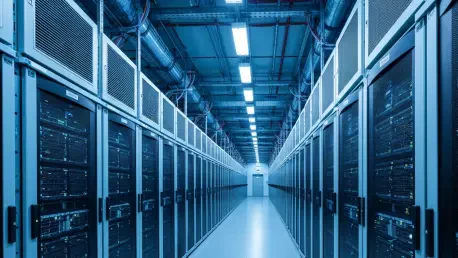In the rapidly advancing realm of artificial intelligence, one company stands out as a driving force behind the unprecedented surge in US infrastructure development, and that company is Anthropic. With its colossal $50 billion investment in state-of-the-art data centers in Texas and New York, Anthropic is spearheading a transformative movement to meet the insatiable demand for computing power. This isn’t merely about constructing facilities; it’s a strategic endeavor to propel AI innovation forward and cement America’s dominance in the global technology arena. The scale of Anthropic’s expansion marks a defining moment for the industry, addressing the critical need for robust infrastructure to support increasingly complex AI workloads. Partnering with Fluidstack, a leader in high-performance GPU clusters, Anthropic is tackling the technical challenges head-on while sparking vital discussions about economic impact, national priorities, and long-term sustainability. This journey into Anthropic’s role reveals how a single company can reshape the landscape of AI infrastructure across the nation.
Powering the Future of AI With Cutting-Edge Facilities
Anthropic’s ambitious projects in Texas and New York are redefining what it means to support AI at scale. These data centers aren’t just physical spaces; they are meticulously engineered hubs designed to handle the enormous computational requirements of training and deploying advanced AI models. Through a strategic alliance with Fluidstack, a firm renowned for its expertise in large-scale GPU clusters, Anthropic ensures that these facilities prioritize power efficiency and high performance. This focus is vital as the demand for AI applications skyrockets, requiring infrastructure that can keep pace with technological advancements. By investing in such specialized centers, Anthropic is laying the groundwork for breakthroughs in AI research, positioning itself as a pivotal player in driving innovation across diverse sectors.
The significance of these facilities extends beyond their technical capabilities, reflecting a broader industry realization about infrastructure’s role in AI progress. Anthropic’s commitment to building data centers tailored for intensive workloads highlights a critical bottleneck in the field: without adequate computing power, even the most promising AI algorithms remain theoretical. This expansion addresses that gap directly, enabling faster development cycles and more sophisticated models. Moreover, the collaboration with Fluidstack showcases how partnerships can amplify impact, bringing together complementary expertise to solve complex challenges. Anthropic’s proactive approach in scaling infrastructure not only supports its own goals but also sets a benchmark for others in the tech ecosystem to follow, reinforcing the urgency of robust systems in an era defined by digital transformation.
Fueling Economic Growth and Opportunity
One of the most tangible impacts of Anthropic’s expansion lies in its contribution to the US economy through job creation and regional development. With projections estimating 800 full-time positions and 2,400 construction jobs tied to the Texas and New York projects, the ripple effects on local communities are substantial. These roles span a range of skills, from technical expertise in data center operations to hands-on construction work, providing a diverse array of employment opportunities. This surge in jobs aligns with national efforts to bolster economic stability through technology-driven initiatives, demonstrating how AI infrastructure can serve as a catalyst for broader prosperity in the regions hosting these facilities.
Beyond immediate employment, Anthropic’s investment fosters long-term economic benefits by attracting ancillary businesses and stimulating local markets. The presence of cutting-edge data centers often draws other tech enterprises, creating clusters of innovation that further enhance economic vitality. This domino effect can lead to improved infrastructure, better educational programs focused on tech skills, and increased investment in surrounding areas. Anthropic’s projects thus act as anchors for growth, transforming not just the job landscape but the entire socioeconomic fabric of the communities involved. By prioritizing domestic expansion, the company contributes to a cycle of opportunity that strengthens the foundation of American economic resilience in the face of global competition.
Supporting National Priorities for AI Dominance
Anthropic’s infrastructure push is closely aligned with the US government’s strategic vision to maintain leadership in artificial intelligence on the world stage. Initiatives like President Trump’s AI Action Plan underscore the importance of retaining high-end computing resources within national borders, driven by imperatives of economic competitiveness and national security. Anthropic’s substantial investment in domestic data centers directly supports this agenda, ensuring that critical AI capabilities are developed and housed in the US. This alignment reflects a shared understanding between industry and policymakers that infrastructure is the bedrock of technological supremacy in an increasingly contested global landscape.
This synergy between corporate action and national policy highlights a broader trend of collaboration aimed at safeguarding America’s technological edge. Anthropic’s focus on expanding US-based facilities responds to growing concerns about reliance on foreign computing resources, a topic of intense scrutiny among lawmakers. By bolstering domestic capacity, the company not only mitigates risks associated with international dependencies but also enhances the nation’s ability to innovate securely. The Texas and New York projects serve as tangible proof of how private sector initiatives can reinforce public goals, creating a unified front to tackle the challenges of AI leadership. This partnership between Anthropic and national objectives sets a powerful precedent for how industry can play a pivotal role in shaping America’s future in technology.
Facing Industry Dynamics and Sustainability Hurdles
As Anthropic scales its infrastructure, it operates within a fiercely competitive environment where other tech titans, such as OpenAI, are also committing vast resources to secure data center capacity across the US. This industry-wide rush underscores the urgency of meeting AI’s escalating computational demands, but it also intensifies the scramble for energy, equipment, and suitable locations. Anthropic must navigate this crowded field, where securing reliable resources becomes as critical as the innovation itself. The competitive pressure highlights a pivotal moment for the sector, as companies race to establish dominance in infrastructure while balancing the need for rapid deployment against finite resources.
Alongside competition, significant challenges loom around the sustainability of such expansive growth in AI infrastructure. The immense energy requirements of data centers place considerable strain on the US power grid, raising questions about long-term viability and environmental impact. Anthropic, alongside its peers, faces the task of innovating not just in AI but in how these facilities are powered and maintained. The availability of specialized equipment further complicates the equation, as supply chain constraints can delay progress. Addressing these hurdles will require a blend of technological ingenuity and strategic planning, ensuring that the drive for AI advancement does not come at the expense of systemic stability or ecological responsibility.
Charting the Path Forward for AI Infrastructure
Reflecting on Anthropic’s bold strides, it’s evident that the company plays a crucial role in elevating the US AI infrastructure landscape through its historic $50 billion commitment. The data centers in Texas and New York stand as testaments to a vision that intertwines technological progress with national strength, creating jobs and fortifying America’s position in global innovation. Despite the challenges of competition and sustainability, Anthropic’s efforts mark a significant chapter in addressing the computational backbone needed for AI’s evolution.
Looking ahead, the focus must shift to actionable strategies that ensure this momentum continues without overtaxing existing systems. Collaborative efforts between industry leaders, policymakers, and energy sectors could pave the way for sustainable solutions, such as integrating renewable energy into data center operations. Additionally, exploring innovative financing models to support further expansion will be essential. Anthropic’s journey offers a blueprint for balancing ambition with responsibility, urging stakeholders to prioritize resilience and foresight in building the next phase of AI infrastructure.









